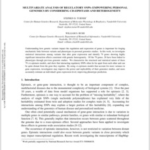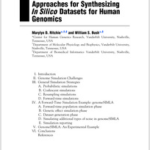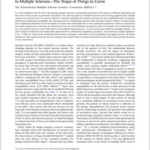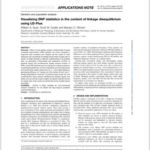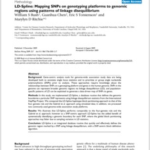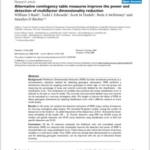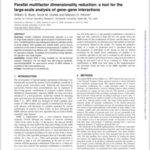Turner SD, Bush WS,. Understanding how genetic variants impact the regulation and expression of genes is important for forging mechanistic links between variants and phenotypes in personal genomics studies. In this work, we investigate statistical interactions among variants that alter gene expression and identify 79 genes showing highly significant interaction effects consistent with genetic heterogeneity. […]
Category Archives: Publications
Genome simulation approaches for synthesizing in silico datasets for human genomics.
Ritchie MD, Bush WS,. Simulated data is a necessary first step in the evaluation of new analytic methods because in simulated data the true effects are known. To successfully develop novel statistical and computational methods for genetic analysis, it is vital to simulate datasets consisting of single nucleotide polymorphisms (SNPs) spread throughout the genome at […]
Evidence for polygenic susceptibility to multiple sclerosis–the shape of things to come.
, Bush WS, Sawcer SJ, de Jager PL, Oksenberg JR, McCauley JL, Pericak-Vance MA, Haines JL,. It is well established that the risk of developing multiple sclerosis is substantially increased in the relatives of affected individuals and that most of this increase is genetically determined. The observed pattern of familial recurrence risk has long suggested […]
Visualizing SNP statistics in the context of linkage disequilibrium using LD-Plus.
Bush WS, Dudek SM, Ritchie MD,. Often in human genetic analysis, multiple tables of single nucleotide polymorphism (SNP) statistics are shown alongside a Haploview style correlation plot. Readers are then asked to make inferences that incorporate knowledge across these multiple sets of results. To better facilitate a collective understanding of all available data, we developed […]
LD-spline: mapping SNPs on genotyping platforms to genomic regions using patterns of linkage disequilibrium.
Bush WS, Chen G, Torstenson ES, Ritchie MD,. Gene-centric analysis tools for genome-wide association study data are being developed both to annotate single locus statistics and to prioritize or group single nucleotide polymorphisms (SNPs) prior to analysis. These approaches require knowledge about the relationships between SNPs on a genotyping platform and genes in the human […]
Alternative contingency table measures improve the power and detection of multifactor dimensionality reduction.
Bush WS, Edwards TL, Dudek SM, McKinney BA, Ritchie MD,. Multifactor Dimensionality Reduction (MDR) has been introduced previously as a non-parametric statistical method for detecting gene-gene interactions. MDR performs a dimensional reduction by assigning multi-locus genotypes to either high- or low-risk groups and measuring the percentage of cases and controls incorrectly labelled by this classification […]
Parallel multifactor dimensionality reduction: a tool for the large-scale analysis of gene-gene interactions.
Bush WS, Dudek SM, Ritchie MD,. Parallel multifactor dimensionality reduction is a tool for large-scale analysis of gene-gene and gene-environment interactions. The MDR algorithm was redesigned to allow an unlimited number of study subjects, total variables and variable states, and to remove restrictions on the order of interactions being analyzed. In addition, the algorithm is […]

